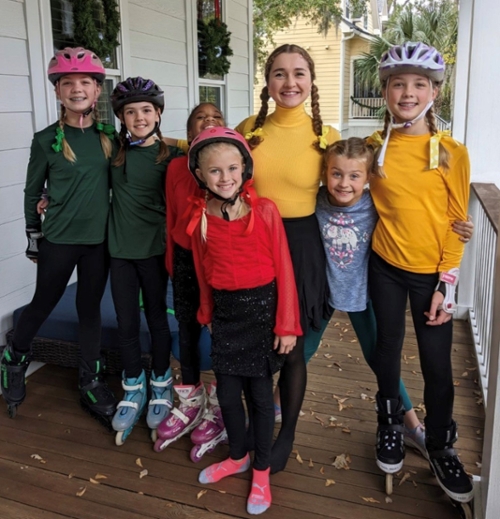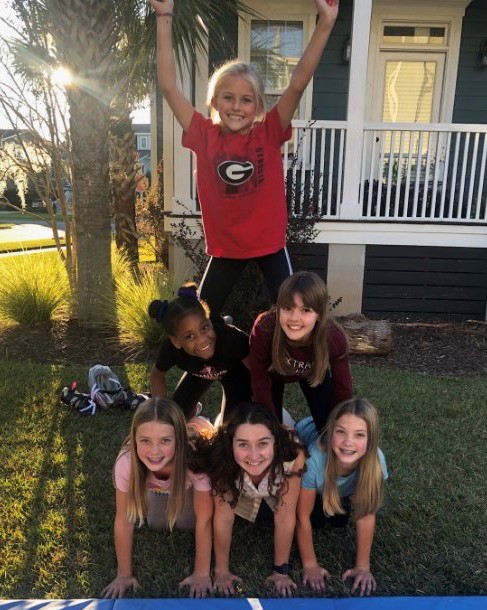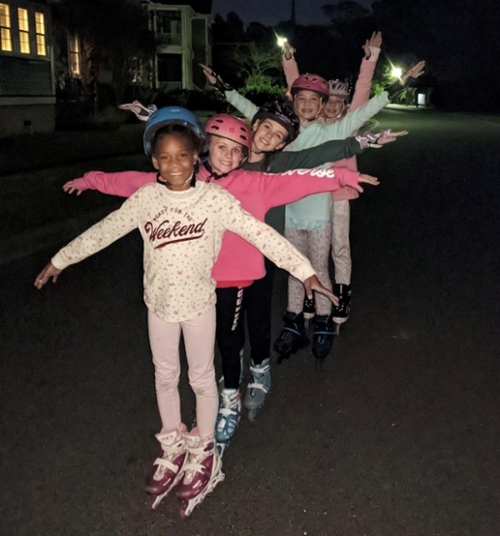The RollerBladingGirls Club: A Community-Engagement Paradigm

An interview by David Goldfarb
An aspiration within our Community Engagement Committee is for our undergraduates, those who experience training and opportunities in engagement while at the University of Rochester, to continue these activities throughout their lives. This is the story of one student whose post-graduate activities model our aspiration.
Zivile Vebraite is a preternaturally cheerful UR graduate (CDM ’21) who hails from Lithuania. A high-achieving undergraduate, she remains committed to her goal of becoming a physician. But it is what Zivile did in her local community after leaving the UR that interests us here. Following her Take 5 year, Zivile moved to Charleston, South Carolina to work at a hospital. It was there, through rollerblading of all things, that she initiated a meaningful engagement with a group of young girls, literally on the fly.
Below Zivile describes the origins of her RollerBladingGirls Club (RBGC), and how the project culminated in the production of a celebratory street performance. Even better, the fun of rollerblading was an entrée for Zivile to mentor her charges in the social and hard sciences. It is best to watch the video of the performance before reading this interview. This is how it is done!
What background in community engagement prepared you for your work with these young girls to create the RollerBladingGirls Club (RBGC)?
There are two important experiences that paved the way for this adventure with the establishment of the RBGC. The first one is Rochester's Lithuanian School. When I came to study at the UR, I joined the school as a teacher. I taught about 15 Lithuanian-Americans of ages 4-16. I was teaching them Lithuanian songs and dances and we would perform these in the Lithuanian-Rochester community during important events such as the Lithuania’s Independence Day or Mother’s Day.
Another important place that gave me knowledge of how to lead a group was a course “Dance and Interdependent Community” taught by Prof. Missy Smith. I took this class as part of my Take Five. Once or twice a week we would go to the Community Place and Jenifer’s House in Rochester and teach the people dance moves and how to be mindful of themselves and others. The Community Place was for retired elders from diverse backgrounds and most of them had medical issues. Jenifer’s House provides social help for homeless women with a criminal history. Although these are very different populations, they taught me patience, adaptation to different populations and vigilance in sensing group dynamics.
What led you to Charleston after graduation from the UR?
After graduation, I took a gap year as I was waiting to hear from Med schools. For my gap year, I wanted to further deepen my clinical research expertise and I wanted to be in a place where I would not freeze most of the year, which is the case in our beloved Rochester. I was offered a position in the Medical University of South Carolina. Here, I have been coordinating tobacco treatment research since August.
What about you do you think attracted these girls to commit to working with you?
My daily commitment to skating; my speed; and my passion to help and empathize in the learning process. As soon as I get off work, I change and jump into my skates for an hour of rollerblading. It wasn’t long before girls playing in their yards noticed me. The girls commented: “I saw you one second here and then I blink, and I saw you already on the other end of the neighborhood. I want to fly like you do”.
Before the idea of establishing a club came to mind, the girls asked me to teach them the basics of skating. When I teach, I put myself in their shoes. Some of them were very scared to try to skate. One girl needed to find trust in my teaching. She was skating forwards, and I was skating backwards holding her hands so she would not fall. I saw her smile, a smile of discovery that gave her confidence that she could do it. Some of them had some background but wanted to learn “cool things.” That required me to be patient with them, reminding them of the technique over and over again, and most importantly - that they have to keep skating, keep trying, keep focusing on that blade’s trajectory and their squat. Just inspiring them that they will get it was encouraging for them.
In our performance you can see that there were a couple of girls who did not wear rollerblades but were still helping out. These girls wanted to be part of the team, but their schedules did not work or they didn’t have rollerblades. I still included them in our practices but gave them unique tasks; their voices were as valuable as the other girls wearing skates.
What is your background in rollerblading?
My dad gave my siblings and me our first rollerblades from a charity he worked with in France. We did not have any protective gear, so we were not allowed to fall down. I was about 6 years old when I started rollerblading up and down the hills in our neighborhood in Vilnius, Lithuania, where I grew up. Also, my friends and I would hold speed-skating competitions in supermarket parking lots, because the pavement there was smooth. Skates were with me wherever I went. My favorite place to skate was in the countryside because there wasn’t much traffic on the roads compared to the busy capital of Vilnius.
When I moved to the Netherlands for high school at United World College, I took my rollerblades there as well. In the Netherlands, everybody bikes to school, work, groceries, trips, etc. For me, no bike could replace my rollerblades, so I continued rollerblading there too. When I came to Rochester for a Bachelor’s degree, I got another pair of rollerblades and I have the best memories of skating by the Genesee River and around the campus. By the way, I tried to use protective gear later when it became available to me, but it felt too foreign. Instead, I continued to honor the agreement with my father never to fall down.
How did you interact with the girls’ parents?
After my first encounter with each girl on rollerblades, I talked to their parents and asked for their permission to train the girls. I got each parent’s phone number and created a group chat. I would inform them when and where we were practicing. I also created surveys for them to complete when we needed to decide on dress rehearsal times and the details for the show. The parents were always informed of when and where we were practicing. At the end of each practice, I would rollerblade each girl to their house to make sure they got there safe and sound. I should note that every one of the girl’s parents approved the release of the photos and video attached to this interview.
How did the idea to develop a routine for a "show" come about?
The girls were inspired to meet someone from Europe in their neighborhood. They wanted to learn more about Lithuania. The routine contains Lithuanian elements. For example, the colors - yellow, green and red - represent the Lithuanian flag; the hair-braids represent the traditional hair-expectations for girls. In the dance, you can see a lot of circular movements - that is one of the most important symbols of generosity and harvest in Lithuania.
Were there any difficulties keeping all the girls happy and progressing?
One of the most challenging parts of keeping the girls happy and progressing was that they came from different learning backgrounds. Some girls had never rollerbladed before, while others had more athletic experiences. I taught the more advanced dancers how to approach those with less experience or talent; specifically, the better dancers would get a task to teach those who were struggling. That way, we were all working towards one goal in a respectful manner.
 Did your rollerblading engagement with these girls allow you to engage with them about other matters?
Did your rollerblading engagement with these girls allow you to engage with them about other matters?
Absolutely! The girls had an opportunity to learn more about physics, biology, and geography. Physics was really handy when teaching the girls about their speed, acceleration and the time needed to come to a full stop. It was also a very important subject when teaching them how to maintain stability on the skates in perspective of where the center of body mass was. Anatomy was an essential part of trainings as well because I explained to the girls what muscles have to be predominantly engaged in the core and lower body in order to maintain certain postures. With regards to geography, it was the girls' idea to make the performance about Lithuania. I had the opportunity to teach them some concepts of Lithuanian traditions, etiquette, and even language (which you can hear at the beginning of the performance: "Labas, ka tu?" means "Hi, how are you doing?" in Lithuanian).
What was the most satisfying part of the experience for you?
The most satisfying part of the experience for me was that the RBGC brought my little local community back together. Before COVID-19, the neighbors were active in organizing social events, but as in most places during COVID-19 everything got canceled or postponed. There was never really a reset. I believe the RBGC made a difference. The girls organized fundraising for the performance twice - the neighbors were kindly encouraged to buy their lemonade and later their ice-cream. The girls made hand-written invitations and distributed them to all the neighborhood (about 30 houses). We ended up having about 40 people in attendance for the performance. It was awesome to see so many neighbors in one place. After the performance, many of them asked me: “So…when is the next recital?”.

